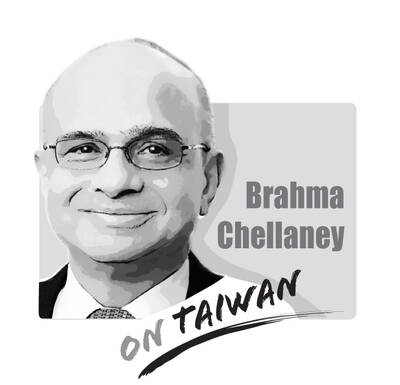If the objective of distributing last year’s tax surplus among the public is economic stimulus, the government’s decision to offer cash handouts is the worst option.
The government settled on handing out cash due to public pressure, leading to accusations that the government is spendthrift. The Chinese Nationalist Party (KMT) and some civil representatives fanned the flames on the Internet to pander to public sentiment.
When the surplus is distributed among the public, people might decide to save it for a rainy day, purchase imported goods or travel overseas. There is no certainty that it would be used to help struggling businesses in Taiwan.
Stimulus vouchers have an expiry date and come with spending restrictions: Holders cannot receive change, and their use is limited to a defined set of products, services and platforms. Consequently, they encourage concentrated buying and provide an immediate economic stimulus.
When the government first introduced stimulus vouchers, people had to spend NT$1,000 to purchase vouchers worth NT$3,000. As people wanted to get their money’s worth, the mechanism made sure that the recipients would spend every last dollar of it.
When issued for the second time, the government bowed to pressure to allow the purchase of NT$5,000 vouchers for NT$1,000. When recipients received vouchers for free in the end, many vouchers were left unused till they expired.
Other schemes such as Arts FUN Go vouchers did not have much luck with the public either, frustrating the government’s attempt to resuscitate the economy. Similarly, if the government offers cash handouts, people might just stow the money away instead of spending it.
For stimulus vouchers to work triple magic, people should be allowed to exchange the vouchers for cash after using them for transactions three times. If the government issues vouchers worth NT$100 billion (US$3.3 billion), and people exchange them for cash after using them three times, the stimulus effect would be worth NT$300 billion.
To track the number of transactions, the program would have to be fully digitized, which would also promote digital finance and mobile payment systems.
After recipients make a purchase, the first transaction would be recorded. After vendors receive the vouchers, they can use them to buy raw materials, marking the second transaction. The shop that effects the third transaction could then receive a government reimbursement.
If there had to be three transactions before reimbursement, the stimulus effect would be tripled. As there would be an expiry date for the vouchers, recipients and vendors would be compelled to spend them quickly, bringing immediate stimulus while reducing the risk of inflation that cash handouts could bring.
For example: A customer might use the voucher to buy breakfast, then the breakfast shop can use them to buy eggs and other ingredients. The chicken farmers then use them to buy fodder and machinery for production. The program would thus benefit different industries from upstream suppliers to downstream retailers.
With cash handouts, there is a high possibility that less than half would be spent locally. As elected officials are pressured by voters, it is natural that cash seems likely to buy their approval.
However, stimulus vouchers that can be reimbursed for money after multiple transactions would be most beneficial to the economy.
Yang Der-yuan is a professor in National Kaohsiung University of Science and Technology’s Department of Money and Banking, and director of the Taiwan Association of University Professors.
Translated by Rita Wang
Recently, China launched another diplomatic offensive against Taiwan, improperly linking its “one China principle” with UN General Assembly Resolution 2758 to constrain Taiwan’s diplomatic space. After Taiwan’s presidential election on Jan. 13, China persuaded Nauru to sever diplomatic ties with Taiwan. Nauru cited Resolution 2758 in its declaration of the diplomatic break. Subsequently, during the WHO Executive Board meeting that month, Beijing rallied countries including Venezuela, Zimbabwe, Belarus, Egypt, Nicaragua, Sri Lanka, Laos, Russia, Syria and Pakistan to reiterate the “one China principle” in their statements, and assert that “Resolution 2758 has settled the status of Taiwan” to hinder Taiwan’s
Singaporean Prime Minister Lee Hsien Loong’s (李顯龍) decision to step down after 19 years and hand power to his deputy, Lawrence Wong (黃循財), on May 15 was expected — though, perhaps, not so soon. Most political analysts had been eyeing an end-of-year handover, to ensure more time for Wong to study and shadow the role, ahead of general elections that must be called by November next year. Wong — who is currently both deputy prime minister and minister of finance — would need a combination of fresh ideas, wisdom and experience as he writes the nation’s next chapter. The world that
The past few months have seen tremendous strides in India’s journey to develop a vibrant semiconductor and electronics ecosystem. The nation’s established prowess in information technology (IT) has earned it much-needed revenue and prestige across the globe. Now, through the convergence of engineering talent, supportive government policies, an expanding market and technologically adaptive entrepreneurship, India is striving to become part of global electronics and semiconductor supply chains. Indian Prime Minister Narendra Modi’s Vision of “Make in India” and “Design in India” has been the guiding force behind the government’s incentive schemes that span skilling, design, fabrication, assembly, testing and packaging, and

Can US dialogue and cooperation with the communist dictatorship in Beijing help avert a Taiwan Strait crisis? Or is US President Joe Biden playing into Chinese President Xi Jinping’s (習近平) hands? With America preoccupied with the wars in Europe and the Middle East, Biden is seeking better relations with Xi’s regime. The goal is to responsibly manage US-China competition and prevent unintended conflict, thereby hoping to create greater space for the two countries to work together in areas where their interests align. The existing wars have already stretched US military resources thin, and the last thing Biden wants is yet another war.